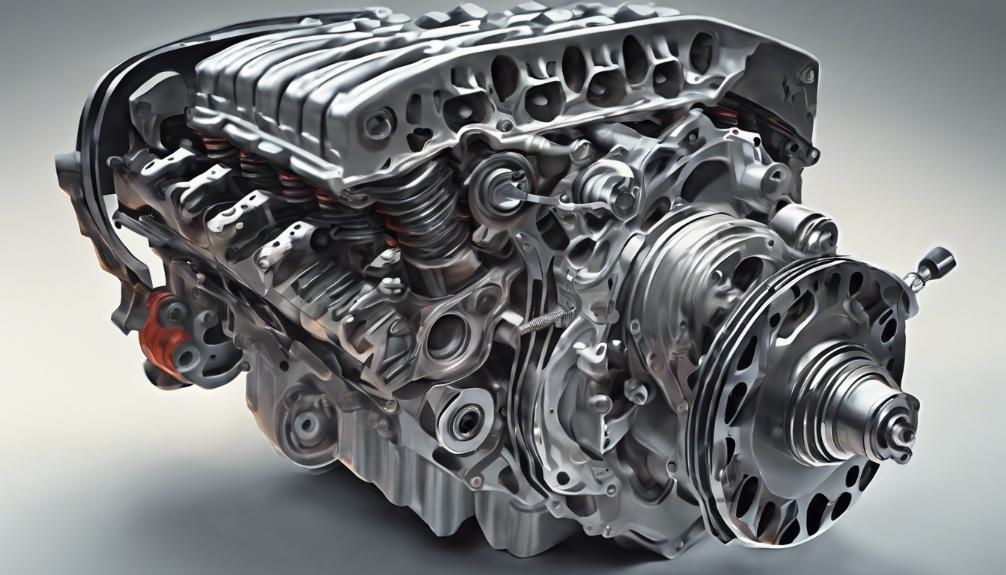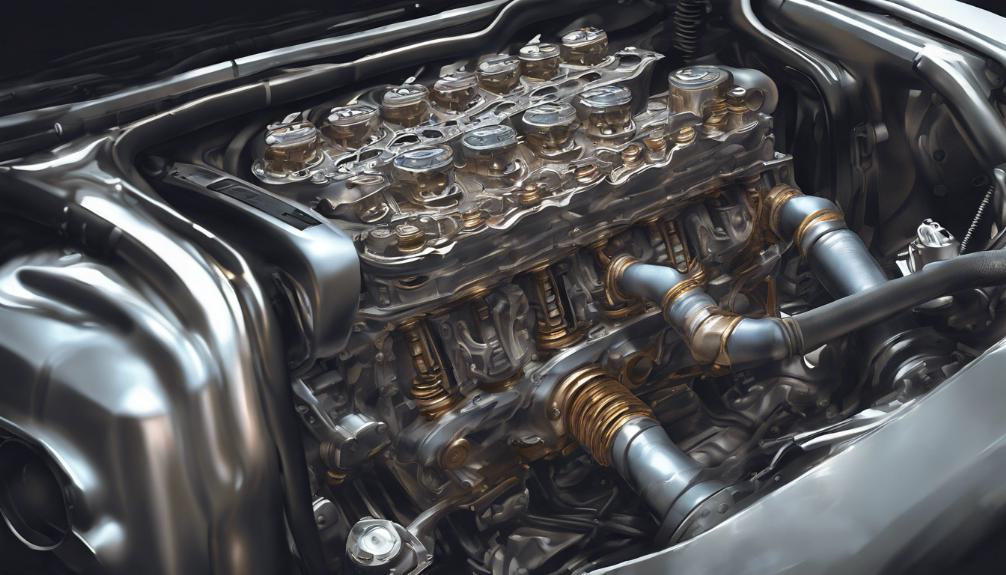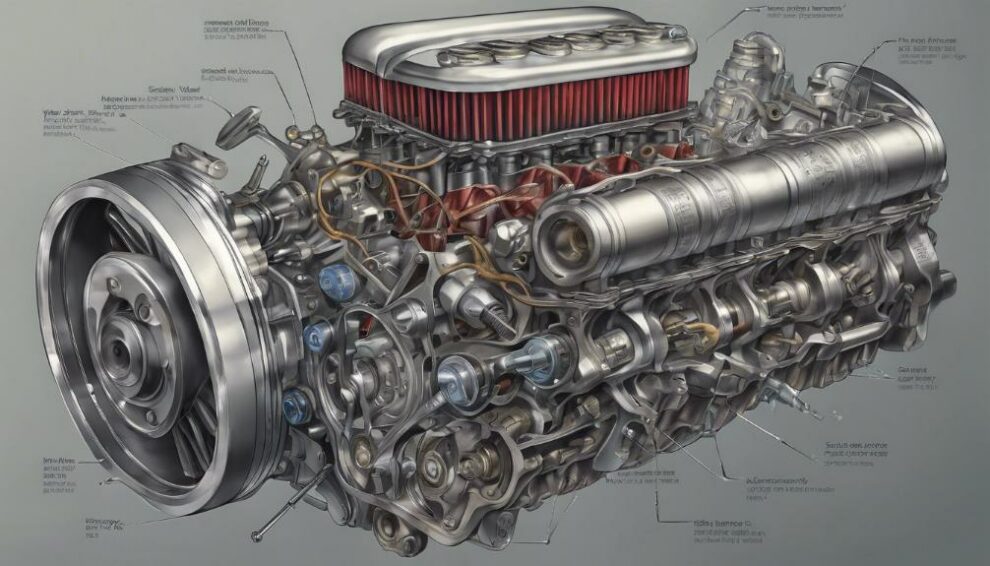Discover essential car engine parts like the engine block, which houses cylinders for combustion and comes in cast iron or aluminum. Pistons, made of aluminum alloy or steel, transfer motion to the crankshaft, converting linear to rotational energy. The crankshaft converts piston motion to force and is usually steel or forged alloy. The camshaft syncs intake and exhaust valves, enhancing engine performance with innovations. Key to operations, the cylinder head seals the combustion chamber and hosts important components like spark plugs. Understanding these parts illuminates how your vehicle functions efficiently.
Key Takeaways
- Engine block materials: cast iron or aluminum alloy ensure structural integrity and containment of combustion process.
- Pistons made of aluminum alloy, steel, or cast iron transfer motion to crankshaft for power generation.
- Crankshaft, made of high-strength steel, converts piston motion to rotational force crucial for engine function.
- Camshaft synchronizes with crankshaft, controls valve operation, and influences engine performance for efficiency.
- Cylinder head seals combustion chamber, houses key components, and ensures heat dissipation and durability under high conditions.
Engine Block Functionality

When examining the functionality of the engine block, durability and structural integrity are paramount considerations. Engine block materials, such as cast iron or aluminum alloy, are vital factors in ensuring the block's ability to withstand the intense pressures and temperatures of the combustion process. Cast iron is known for its strength and resistance to wear, making it a popular choice for heavy-duty applications. On the other hand, aluminum alloy offers a lightweight alternative with good heat dissipation properties, enhancing overall engine efficiency.
The structural integrity of the engine block is essential for maintaining the alignment and stability of critical components within the engine. It houses the cylinders where combustion occurs, ensuring that the process is contained and controlled. Furthermore, the block provides mounting points for various engine parts, such as the pistons and crankshaft, allowing them to function harmoniously to convert combustion energy into mechanical motion. Overall, the choice of materials and the design of the engine block are fundamental in optimizing engine performance and longevity.
Piston Operation Overview
Understanding how pistons operate within a car engine is essential for grasping the mechanics behind converting fuel combustion pressure into mechanical motion efficiently. Pistons, which are cylindrical components, play an important role in the combustion process. Their design allows them to move up and down within the cylinders, creating a sealed chamber for controlled explosions to drive the engine forward.
Typically made of materials like aluminum alloy, steel, or cast iron, pistons are built to withstand the high temperatures and pressures generated during combustion. As the pistons move, their motion is transferred to the crankshaft through connecting rods, converting the linear motion into rotational energy that powers the vehicle.
Ensuring proper piston operation is crucial for efficient power generation and maintaining smooth engine performance. By understanding the intricacies of piston design and their function in the combustion process, you can appreciate how these essential components work together to keep your engine running smoothly.
Crankshaft and Its Role

Located in the lower section of the engine, the crankshaft is an essential component responsible for converting the linear motion of the pistons into rotational motion. Connected to the pistons via connecting rods, it rotates to transfer power to the gearbox, ultimately propelling the vehicle. The crankshaft's role in transforming the up-and-down piston motion into rotational force is important for various vehicle functions. The design and material of the crankshaft, often high-strength steel or forged alloy, are critical for durability and efficiency.
To guarantee performance efficiency, proper maintenance of the crankshaft is necessary. Regular checks for wear and tear, balancing, and alignment are essential to prevent issues that could affect the engine's operation. Neglecting crankshaft maintenance can lead to poor engine performance, increased fuel consumption, and even engine failure. By prioritizing crankshaft care, you can contribute to the smooth operation of your engine and overall vehicle performance.
Understanding the Camshaft
Operating in sync with the crankshaft, the camshaft serves as a critical engine component controlling the opening and closing of intake and exhaust valves. The camshaft is driven by the crankshaft either through a timing belt or chain, ensuring precise coordination between valve operation and piston movements.
Its lobes are instrumental in determining valve timing and lift, directly influencing engine performance and efficiency. Innovations in camshaft technology have led to the development of overhead camshaft (OHC) designs, positioning the camshaft above the cylinder head. This arrangement enhances valve control, optimizing the regulation of the air-fuel mixture intake and exhaust gas expulsion for improved engine operation.
Through continuous advancements in valve control innovations, the camshaft continues to play a key role in enhancing the overall functioning of modern car engines, contributing significantly to their efficiency and performance.
Importance of Cylinder Head

With its pivotal role in sealing the combustion chamber and controlling key engine processes, the cylinder head stands as an essential component necessary for the efficient operation of a car engine. The cylinder head plays a critical role in making sure that the combustion chamber is sealed properly during the combustion process. It houses important components such as valves, spark plugs, and fuel injectors that are essential to the engine's functioning.
Proper maintenance of the cylinder head is vital to prevent issues like leaks, overheating, and loss of compression, all of which can greatly impact engine performance. Cylinder heads are securely attached to the engine block using cylinder bolts to ensure a tight seal, allowing for the proper functioning of the combustion chamber. The design and construction of the cylinder head are optimized for efficient heat dissipation and durability under high-temperature and high-pressure conditions.
Regular cylinder head maintenance is necessary to keep the engine running smoothly and efficiently.
As an Amazon Associate we earn from qualifying purchases.










